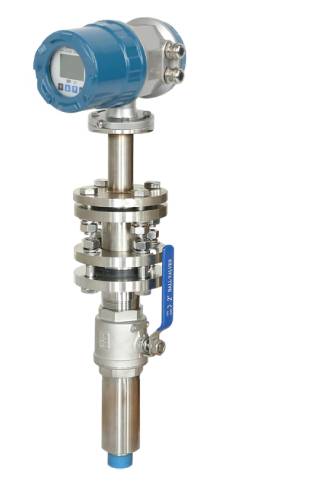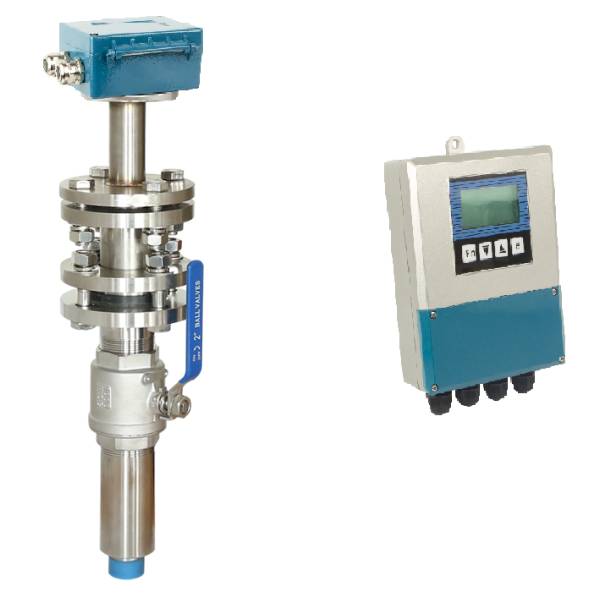The insertion type magnetic flow meter is a plug-in electromagnetic flow meter that is used to measure the flow of conductive fluids in various industries, including tap water, steel, petroleum, chemical, electric power, water conservancy, water administration, and water resources. It can also measure corrosive conductive liquids, such as acids, alkalis, and salts.
The flow meter is made of corrosion-resistant stainless steel material, and the ABS full mold production probe has a simple structure, firmness, no moving parts, and a long service life. It has reliable measurement and strong anti-interference ability, and its small size, lightweight, and easy installation make it low maintenance. It has a large measurement range, and the measurement is not affected by temperature, density, pressure, viscosity, conductivity, etc. The pressure loss is zero, and it can be installed and disassembled under continuous flow, which brings convenience to the user’s maintenance. Compared with the general electromagnetic flow meter, the manufacturing cost and installation costs are lower. It is especially suitable for large and medium-caliber pipeline flow measurements.

The insertion-type magnetic flow meter adopts advanced processing technology, solid-state packaging, vibration resistance, long life, and other characteristics so that the meter has good measurement accuracy and stability. The flow meter not only has 4-20mA current signal output but also 1-2000HZ frequency output digital communication output: RS485, RS232, HART, Modbus.
The main technical performance indicators of the insertion type magnetic flow meter are as follows:
- Flow velocity measurement range: (0.05-10) m/s
- Measuring pipe diameter: DN (32-3000) mm
- Measurement accuracy: 0.5-1.0 level
- Working pressure: <1.6MPa
- Medium temperature: 0-80℃
- Power consumption: <20VA
- Connection mode: flange connection, threaded connection
- Working voltage: 220V, 3.6V
The insertion type magnetic flow meter sensor should be installed in the upstream straight pipe section not less than 5D (D represents pipe diameter), and the downstream straight pipe section is not less than 2D. There are two installation methods, vertical and inclined installation. The axis of the sensor and the axis of the pipeline being measured are at an angle of 45° for inclined installation. The insertion point of the sensor can be inserted into the central axis of the pipe under test (that is, 1/2 times the pipe diameter) or into the inner wall of the pipe at 1/4 of the pipe.

The insertion-type magnetic flow meter has a simple and reliable instrument structure and is free from blocking and flow-blocking parts, and there is no pressure loss and fluid blockage. The measurement accuracy is not affected by the type of the measured medium and its temperature, viscosity, density, pressure, and other physical parameters. Different combinations of PTFE or rubber lining and Hc, Hb, 316L, Ti, and other electrode materials can meet the needs of different media.
The insertion type magnetic flow meter has a variety of models, including pipeline type and plug-in type, and can be used for detecting liquid flow rates of water, sewage, acid, strong alkali, and other conductivity above 5us/cm. It is widely used in the industrial production processes and energy measurements, as well as transportation, biotechnology, and scientific experiments.
In terms of the industrial production process, the insertion-type magnetic flow meter is an important tool for developing industrial and agricultural production, saving energy, improving product quality, and improving economic efficiency and management. It is used in various industries, including metallurgy, electric power, coal, chemical, petroleum, transportation, construction, textile, food, medicine, and agriculture.
Regarding energy measurement, the insertion type magnetic flow meter is an important means to manage energy scientifically, realize energy saving and consumption reduction, and improve economic efficiency. It is an important part of energy measurement instruments for commonly used energy sources such as water, artificial gas, natural gas, steam, and oil.

In transportation, the insertion type magnetic flow meter is essential for pipeline transportation, which must be equipped with flow meters. Flow meters are the eyes of control, distribution, and dispatch, as well as an indispensable tool for safety monitoring and economic accounting.
In biotechnology, the insertion type magnetic flow meter is used to monitor and measure many substances in biotechnology, such as blood and urine. The instrument development is extremely difficult, and there are many varieties, and the market potential of the insertion type magnetic flow meter is huge.
In scientific experiments, the insertion type magnetic flow meter is needed for various experiments that require flow meters. It is available in different varieties and is essential for scientific experiments.

In conclusion, the insertion-type magnetic flow meter is an important tool for measuring the flow of conductive fluids in various industries. It has a simple structure, firmness, long service life, and reliable measurement. It is low maintenance, has a large measurement range, and is not affected by temperature, density, pressure, viscosity, conductivity, etc. It is widely used in industrial production processes and energy measurement, transportation, biotechnology, and scientific experiments. It has different models, including pipeline type and plug-in type, and is essential for detecting liquid flow rates of water, sewage, acid, strong alkali, and other conductivity above 5us/cm.
